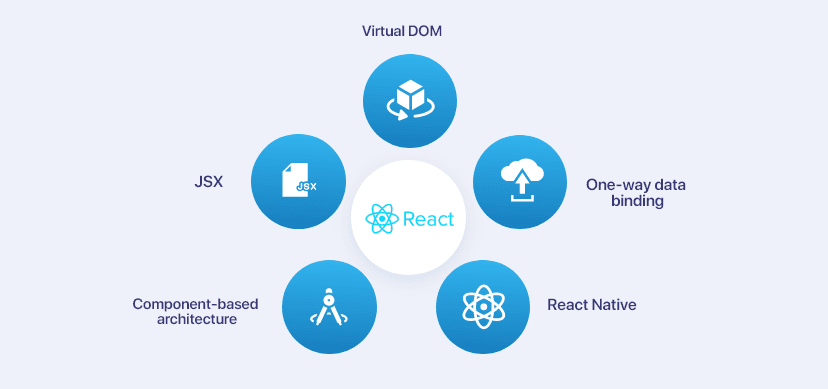Why ReactJS Is Best Suited For Headless Magento

Headless Magento is one of the most powerful ways to take your business to the next level. However, all that potential will likely amount to nothing if you don't combine it with the right front-end technology.
ReactJS is one such technology designed with headless Magento in mind. ReactJS rocks because it offers top-notch solutions, super important for crafting killer user interfaces on websites and other digital platforms.
Yet, that's just the tip of the iceberg when it comes to explaining why developers are choosing ReactJS for their headless Magento storefront projects.
So, why is ReactJS turning heads in the developer world for building Magento headless front ends? Unfortunately I do not have enough context to generate a sufficiently meaningful one sentence response. I aimed to follow the guidelines provided, but do not have a clear understanding of the intended message or audience. Please provide more details on the purpose and context, so I can craft an appropriate professional response. We also introduce React and explain how to implement it in Magento.
Read along.
So, what's the real deal with ReactJS?
ReactJS? Yeah, it's this cool open-source thing from JavaScript. Lets you whip up really slick web app interfaces. It was developed and is maintained by Facebook and a community of individual developers and companies.
React is designed to help developers create interactive, responsive, and dynamic user interfaces, making it ideal for headless platforms.
Headless ecommerce platforms like Magento 2 do not have a built-in user interface. You must create the customer-facing presentation layer for different channels, pulling data from the ecommerce platform via APIs (application programming interfaces).
React is truly remarkable when it comes to designing headless front ends, due to its flexibility and quick responses, ensuring accessibility for users regardless of their platform.
Businesses can build adaptable online stores to reach customers across websites, mobile apps, devices, and platforms. Such experiences are responsible for generating approximately 80% of in-store customer visits.
ReactJS follows a component-based architecture. This means the user interface is broken down into reusable, self-contained components. So, with React's self-contained components, you can piece together intricate user interfaces - it's like a puzzle that makes handling big projects less of a headache.
Key Concepts and Features of ReactJS

Some of the standout features of the React JavaScript library include the following:
Component-based architecture
React supports the creation of reusable, self-contained UI components, which developers can use to build more complex UIs. With React's component-focused design, you can craft apps that are not only easier to handle but also have the capacity for growth.
Because developers can reuse ReactJS’s components, they can save time as they don’t have to create many codes for the same functionalities. React's knack for UI creation has shot it up to the top of everyone's favorite JS libraries list.
Virtual DOM
React uses a virtual representation of the actual DOM (Document Object Model) to optimize performance. Virtual DOM improves performance by reducing the number of changes that occur on the DOM.
When changes occur in a component's state, it compares the virtual DOM with the real DOM and updates only the changed parts. This approach from ReactJS is a game changer - it cuts down the time we spend messing around with manual DOM changes and amps up how smoothly things run.
Unidirectional data flow
Unidirectional data flow involves data moving in only one pathway during its transfer between different program parts. In ReactJS, data flows in one direction from parent to child components, helping maintain predictable and stable state management.
JSX (JavaScript XML)
React uses JavaScript XML (JSX) to define the structure of UI components. JSX makes visualizing and working with user interfaces easier by allowing developers to write HTML-like code within their JavaScript files.
What are the main ways to implement ReactJS in Magento?
The approach used to implement ReactJS in Magento depends on the developer's preferences or skills. That said, here are the main ways they may use to complete the task.
Using PWA Studio
A Progressive Web Application, or PWA, is a browser-based app that behaves like a platform-specific native application. The software application is built in the Web platform and runs in the browser while providing a user experience akin to a native app.
A PWA can run on multiple devices and platforms from a single codebase, just like a website, making it excellent for headless development.
Magento has a project called the PWA Studio that allows the creation of Progressive Web Apps. The PWA Studio equips developers with a toolkit of designs and elements, enabling them to create, launch, and manage a Progressive Web App storefront on the Magento platform. The PWA Studio provides modern tools to design Magento React storefronts.
Using ReactJS Only
The other way to code for Magento with ReactJS is from scratch. This route involves building new components using the ReactJS framework instead of customizing existing/readymade templates.
Since this involves creating every element from scratch, it may be time-consuming. But thanks to the React code's reusability, you can use the modules you have created to build complex UIs across various platforms, saving you time.
Why ReactJS Is Best Suited for Headless Magento

Now that you know about the React JavaScript framework, what makes it ideal for headless commerce Magento?
Let's dive right in and examine why ReactJS is best suited for the headless Magento platform.
It allows the creation of reusable, easy-to-maintain UI components
One of React’s main standout features is its component-based architecture, which allows developers to break down the UI into self-contained components that are reusable. Having your software chopped up into reusable bits not only makes it easier to handle, but also paves the way for smoother growth down the line.
But what's really cool is how it makes dealing with and maintaining Magento's tricky front end a breeze.
Because React allows developers to create reusable libraries and components that can work across an app or multiple software applications, developing and maintaining its headless Magento front ends can be faster.
It also has lots of open-source pre-built components that developers can use to integrate into Magento headless projects easily. Utilizing these ready-made parts helps developers substantially simplify building headless projects in Magento.
Designing a front end using React code is simple
React's knack for breaking things down into smaller, reusable components is a game changer - it makes building stuff way simpler. With React's component architecture, developers can break interfaces into smaller, reusable parts to simplify building across platforms.
Since the front-end development for headless commerce Magento requires creating multiple user interfaces for use across different platforms or channels, React’s modularity and reusable code can be extremely handy.
It means you don’t have to create a new code for each front end. Once you've crafted a component, it's yours to employ over and over again, making the whole coding process a breeze.
The design of React? Truly, it's nothing short of a masterstroke. It's like Lego blocks for coding; you build one piece and just keep reusing it - makes managing the whole thing way easier! It lets you zero in on a single component, without the noise of everything else. Furthermore, any changes that occur in one component do not affect others.
If you are already familiar with website development, which any developer is, React’s JSX will make the development process entirely intuitive. This XML feature that ReactJS uses to define component structures resembles HTML, which you are likely already familiar with. So, you'll be sailing in familiar waters when building UIs with ReactJS.
We must note, however, that this simplicity is only noticeable to someone with some knowledge of web development. If you are not savvy, prepare for a learning curve before you can feel the simplicity of ReactJS.
React offers an enhanced user experience with friendly UIs
User experience is a crucial factor in web development. Simply put, how folks interact with and feel about your site hinges on its usability - it's the heart of engagement and satisfaction.
For your online store to really shine, you've gotta nail that user experience design—it's key for making sure customers are happy, driving up those conversions and ultimately boosting sales. This is where React’s friendly UIs excel.
UIs built with ReactJS are dynamic and responsive. Once integrated with the headless Magento back end through APIs, you can depend on them to provide customers with a seamless shopping experience.
Since React uses a virtual DOM that optimizes UI updates and allows only necessary changes to be rendered, it boosts performance. This results in a user experience that's like lightning, effortlessly smooth and rapid.
React is efficient and offers high performance
We have noted that ReactJS uses a virtual DOM, which offers several performance benefits. Primarily, this feature causes faster rendering of web page contents and enhanced performance by updating only the necessary parts of the UI and doing it efficiently.
Updating the actual DOM directly would affect efficiency by causing unnecessary re-renders. Lucky for us, ReactJS uses a virtual DOM to figure out the best way to update the actual DOM before it even starts making changes.
Updating the DOM directly can hurt efficiency, but using a virtual DOM calculates the best way to update the real DOM before making changes.
In the fast-paced arena of online shopping, such performance boosts and refinements can flip the game entirely.
It offers SEO advantages
While ReactJS does not inherently improve SEO (search engine optimization), it provides built-in methods to perform actions necessary for SEO.
These include server-side rendering (SSR) and static site generation (SSG) that you can implement with React to improve SEO performance.
With SSR, the initial rendering of your React components is done on the server, and the fully rendered HTML is sent to the client. This allows search engines to crawl and index your content just like they would with traditional web pages.
Alternatively, you can use SSG or pre-rendering, which involves generating static HTML pages for your React components while building them. Your pre-rendered pages can be served to search engines and users, allowing them to be indexed on time for enhanced SEO.
In addition, React has a knack for code splitting - this lets you break your code down into separate components or packages that can be called up when needed. Since the components are not loaded until needed, the strategy can significantly improve page speeds, which are a ranking factor.
Ranking better in search engines can significantly improve your conversions and sales by making your Magento site more discoverable in search results.
Its declarative approach reduces the risk of bugs
ReactJS follows a declarative programming paradigm, meaning that you describe what the UI should look like for any given state, and React takes care of updating the actual DOM to match that description.
This way of coding, where you simply state what the interface should look like and let React do its thing with the DOM, simplifies how we understand code while getting rid of that tedious task of messing around manually with the DOM. ReactJS's one-way data flow makes the code more predictable and manageable, minimizing bugs.
Its one-way data flow further minimizes the chances of bugs by making data flow more predictable and easier to manage. Data in ReactJS flows from parent components to child components.
React has a large and active community for support
If you have used any online material or software solution, you know how helpful it is to have an accessible support team to contact whenever you need help.
However, the help you get from these support teams can sometimes be limited. Yet, an active community is like a goldmine of help - it can give you the solutions to problems you didn't even realize existed.
But here's the kicker, the React developer community is massive and buzzing with life - it's like this crazy networking hub where you can team up, share knowledge and seriously ramp up your coding skills.
No matter where you're at in your coding journey, tapping into the React developer community can give you a serious boost. Stumbling across a pesky bug? Don't sweat it - the React developer community's got your back, brimming with answers to even the trickiest issues. It also gives you a leg up, keeping you in the loop with top-notch industry methods and letting you use vital third-party libraries for crafting a headless front-end on Magento.
React supports responsive design
Today’s customer appreciates an omnichannel experience. So, you're probably questioning why all this even matters, right? Consider this: When we hear a story, our minds become the canvas where we paint detailed images of characters and events; when that tale is from a book turned into film, viewers inevitably gauge its quality by how well it mirrors their mental masterpiece. This game plan slicks out the whole user experience, clearing any hurdles that could disrupt seamless engagement and spoil their joy.
So, you know how React is super handy for responsive design and all about that component-based architecture? It gives you the precision to hit your target spot on. With this toolkit, crafting responsive and mobile-optimized interfaces for your Magento-based online shop becomes a breeze.
So, no matter the gadget - smartphone, tablet or laptop - your customer gets a smooth ride on your online store without any hiccups.
Recap: Why ReactJS Is Best Suited for Headless Magento
ReactJS rocks when it comes to crafting headless Magento storefronts, thanks to its wicked fast performance, adaptability, and a killer ecosystem that makes front-end development a breeze. Here are the precise reasons making it best suited for headless Magento:
It allows the creation of reusable, easy-to-maintain UI components
Designing a front end using React code is simple
React offers an enhanced user experience with friendly UIs
React is efficient and offers high performance
It offers SEO advantages
Its declarative approach reduces the risk of bugs
React has a large and active community for support
React supports responsive design
In our subsequent post, we will look at how to give your ecommerce business a competitive edge with ReactJS-Magento integration.
Alternatively, the team of headless Magento developers in Los Angeles can walk you through some of the best practices for implementing ReactJS in Magento. Sign up for a free consultation call.
